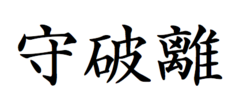Shuhari

Shuhari (Kanji: 守破離 Hiragana: しゅはり) is a Japanese martial art concept that describes the stages of learning to mastery. It is sometimes applied to other disciplines, such as Go.
Etymology
[edit]Shuhari roughly translates to "to keep, to fall, to break away" or "follow the rules, break the rules, transcend the rules".
Shuhari can be decomposed in 3 kanjis:
- shu (守) "protect", "obey"—traditional wisdom—learning fundamentals, techniques, heuristics, proverbs.[1]
- ha (破) "detach", "digress"—breaking with tradition—detachment from the illusions of self, to break with tradition - to find exceptions to traditional wisdom, to find new approaches. In some styles of Japanese music (gagaku and noh), it is also the middle of the song.[1]
- ri (離) "leave", "separate"—transcendence—there are no techniques or proverbs, all moves are natural, becoming one with spirit alone without clinging to forms; transcending the physical - there is no traditional technique or wisdom, all movements are allowed. [1]
While the concept of Shuhari is very old, and most often identified with martial arts in general, it actually has its roots in early Japanese theater and poetry.
This historical context is important because part of the literal meaning of Shuhari has also evolved.
In feudal Japan (including during the entire shogunate/pre-Meiji Restoration era), the "ri" of shuhari was expressed with the kanji 離 .
Ri was about four kilometers – specifically, 3,927.6 meters as standardized in the 17th century: 36 cho (町), with each cho measured at 109.9 meters). The ri was a standard unit of far-distance measure just like a kilometer or mile is today.
However, as time evolved and a modern Japan emerged, ri came to mean a subset of its former meaning: a village or even place of birth (especially in the sense of a small town of birth). This is because fiefdoms, which centered around villages, were measured in ri. As the concept of fiefdoms receded and then disappeared, the meaning of ri changed from the distance that included the village to the village itself.
At that point, the "ri" of shuhari became ri, still maintaining the idea of large distance, but now meaning "to leave or separate away."[1]
Definition
[edit]Aikido master Endō Seishirō shihan stated:
"It is known that, when we learn or train in something, we pass through the stages of shu, ha, and ri. These stages are explained as follows. In shu, we repeat the forms and discipline ourselves so that our bodies absorb the forms that our forebears created. We remain faithful to these forms with no deviation. Next, in the stage of ha, once we have disciplined ourselves to acquire the forms and movements, we make innovations. In this process the forms may be broken and discarded. Finally, in ri, we completely depart from the forms, open the door to creative technique, and arrive in a place where we act in accordance with what our heart/mind desires, unhindered while not overstepping laws."[2]
History
[edit]
The Shuhari concept was first presented by Fuhaku Kawakami as Jo-ha-kyū in The Way of Tea, "Sado 茶道". Fuhaku based his process from the works of Zeami Motokiyo, the master of Noh, which then became a part of the philosophy of Aikido.[3]
Shuhari can be considered as concentric circles, with Shu within Ha, and both Shu and Ha within Ri. The fundamental techniques and knowledge do not change.[4][5]
During the Shu phase the student should loyally follow the instruction of a single teacher; the student is not yet ready to explore and compare different paths.[6]
See also
[edit]References
[edit]- ^ a b c d "Shuhari — The Stages of Learning 守破離". Goju Karate. 2024-07-12. Retrieved 2024-07-14.
- ^ An Interview with Endô Seishirô Shihan Archived 2011-06-10 at the Wayback Machine Aiki News, Dou, No. 144 (2005). translated by Daniel Nishina and Akiya Hideo
- ^ On the Art of the No Drama: The Major Treatises of Zeami Motokiyo. Princeton University Press. 1984-02-21. ISBN 978-0691101545.
{{cite book}}: CS1 maint: date and year (link) - ^ "The Meaning of Shuhari". Retrieved 1 June 2006.
- ^ Masayuki, Shimabukuro (2008-01-15). Flashing Steel - Mastering Eishin Ryu Swordsmanship (2nd ed.). Blue Snake Books. ISBN 978-1583941973.
{{cite book}}: CS1 maint: date and year (link) - ^ McCarthy, Patrick, "The World within Karate & Kinjo Hiroshi" in Journal of Asian Martial Arts, V. 3 No. 2, 1994.
